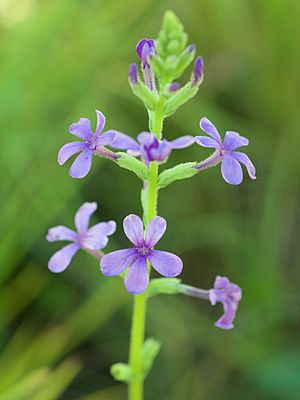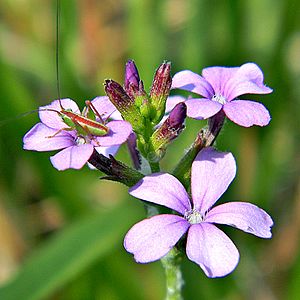American bluehearts facts for kids
Quick facts for kids American bluehearts |
|
|---|---|
 |
|
| Buchnera americana | |
| Scientific classification | |
| Genus: |
Buchnera (plant)
|
| Species: |
americana
|
American bluehearts, also called Buchnera americana, is a special plant known for its pretty purple flowers. It is a type of plant that lives for many years, called a perennial. This plant belongs to the broomrape family, Orobanchaceae. You can find American bluehearts in many parts of the eastern United States. It also grows in one small area in Ontario, Canada.
Contents
About American Bluehearts
American bluehearts is a flowering plant that grows year after year. It has underground stems called rhizomes that help it spread. The stem that grows above the ground is often covered with tiny hairs, called trichomes. These stems can grow to be about 40 to 80 centimeters (16 to 31 inches) tall.
The leaves of the plant grow in pairs, directly across from each other on the stem. The flowers are a light purple color. After the flowers, small, dark purple fruits grow in capsules. These capsules are about 7 millimeters (0.3 inches) long.
American bluehearts can bloom all year, but their flowers look best from June to September. During the other months, the petals become darker and dry out.
Where Bluehearts Live
You can find American bluehearts in 12 different states in the United States, from Ohio all the way down to Florida. They are most common in Missouri and Tennessee, where they like to grow in wet places.
In Canada, this plant only grows in a small area of southwestern Ontario. This spot is about 10 kilometers (6 miles) from Lake Huron.
American bluehearts usually grow near wet areas, like the edges of ponds or in wet, sandy soil. They also like open woods and special grassy areas called prairies. Sometimes, they can even grow by attaching to the roots of trees. This is a special relationship where they get some nutrients from the tree.
Protecting Bluehearts
In Canada, American bluehearts are very rare. They are only found along a 10-kilometer (6-mile) stretch of the Lake Huron shoreline in Ontario. Only six groups of these plants exist there. Because of this, they are considered an endangered species in Canada.
In the United States, bluehearts are found in 11 states. Their rarity in each state is ranked from S1 to S5:
- S1 means they are extremely rare.
- S5 means they are common and safe.
- Bluehearts are S1 in Georgia and Virginia.
- They are S2 in Ohio and Texas.
- They are S3 in Illinois, Kansas, Tennessee, and parts of Kentucky.
- They are S4 in Arkansas, Missouri, and other parts of Kentucky.
One big threat to bluehearts in Ontario is new buildings. Houses, cottages, and parks are being built where the plants naturally grow. In parks, people might accidentally step on or pick the flowers.
In the United States, bluehearts often live in prairies. These prairies need fires every 3 to 4 years to stay healthy. Fires help new seeds grow and keep other plants from taking over. If these fires don't happen, bluehearts can lose their habitat. This is a big problem in states like Indiana, Illinois, Missouri, and Ohio.
Bluehearts in Nature
American bluehearts are called "hemiparasitic" plants. This means they can grow on their own, but they grow much better and stronger if they attach to another plant, like a tree. They connect to the host plant's roots using special roots called haustoria.
If there's a tough time, like a drought, bluehearts might take more nutrients from their host. If many bluehearts are growing on a small tree, they could even harm it. Some common trees that bluehearts attach to are:
- White oak (Quercus alba)
- Eastern white pine (Pinus strobus)
- Green ash (Fraxinus pennsylvanica)
- Cottonwood (Populus deltoides)
The caterpillars of the common buckeye butterfly (Junonia coenia) also like to eat the leaves of the blueheart plant.
Uses of Bluehearts
As far as we know, American bluehearts are not used for medicine. However, they are very important for nature. Bees, butterflies, and birds love this plant, making it a great addition to gardens that want to attract wildlife.


